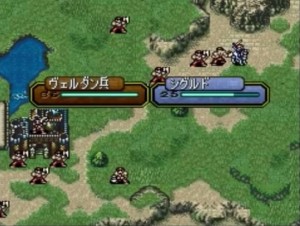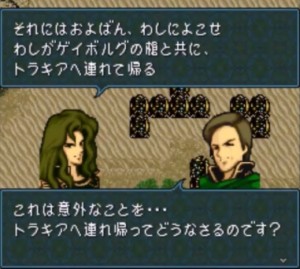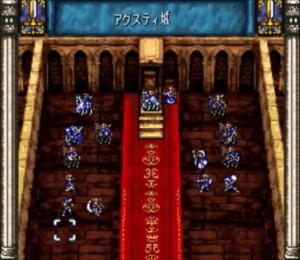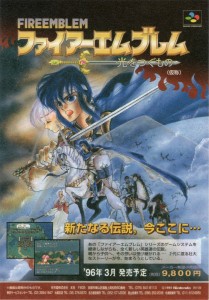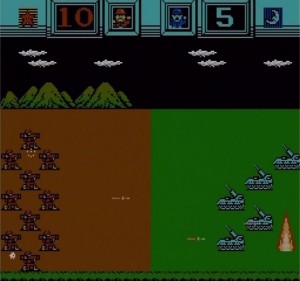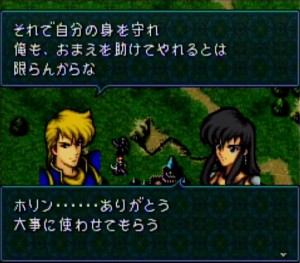Around a month ago, Genealogy of the Holy War celebrated its 20th anniversary. Recent Fire Emblem games owe a lot to Genealogy for introducing hugely popular gameplay elements such as special skills, marriage and children.
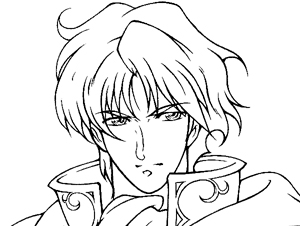
Sigurd lineart; scan provided by Kirokan.
Therefore, it’s very appropriate that our next “Making Of” article delves into the development history of this crucial entry in the series. As before, we’ve teamed up with the extremely hard-working Kirokan from Kantopia to bring you all the juicy details.
Unlike previous articles, the information we’ve gathered does not come from development documents included in the Making of Fire Emblem book, but naturally during the course of interviews with key Fire Emblem staff.
Genealogy is first brought up when Masahiro Higuchi, currently a producer at Intelligent Systems, discussed his first involvement with the Fire Emblem series. Back then, Higuchi was a graphic designer who worked on designing Genealogy’s dynamic map sprites.
For those unaware, when combat animations are disabled in the Jugdral games (Genealogy and its follow up, Thracia 776), the characters’ map sprites fight during combat, swinging their swords or casting magic, etc. Whereas in the GBA entries, the map sprites simply “bump” into each other.
As Higuchi reminisced about the past, he recalled a time when Genealogy was known under a different name: “Holy Sword Elm Kaiser“. Apparently the early concept for Genealogy was remarkably different from previous Fire Emblems, so the team felt the need for a completely different name to set it apart
Originally, it was called, “Holy Sword Elm Kaiser.” It was because the team back then had ideas for a game that was slightly different than the usual FE in mind.
–Masahiro Higuchi from the Making of Fire Emblem
Sadly, Higuchi did not spare time to explain why they chose that particular name, so it’s left to our imagination. Of course, swords play a key role in Fire Emblem (and most Japanese-style RPGs), so that may partially explain the first half. The “holy” part could be indicating that the sword is special or has a righteous purpose.
Actually, seeing as the “holy” keyword was reused for the final name, perhaps it had an important symbolic significance? In an in-depth interview in the Fire Emblem: Treasure book, the game’s producer Shouzou Kaga suggested how “holy war” could refer to a righteous battle as viewed by one side of a conflict.
For example, from Sigurd and Seliph’s perspective, they’re waging a “holy war” against their enemies. However, their enemies are also waging a “holy” war against Sigurd and Seliph. Maybe the “holy sword” was analogous to the “holy war” concept: our heroes would be wielding a “holy sword”, but their enemies might consider it a “demonic sword”.
Presumably “Elm Kaiser” was the name of the holy sword, although it’s hard to make any sense from it. The only thing “Elm” seems to allude to is trees, while “Kaiser” is another word for “king” or “emperor”. So a king of trees? Well, perhaps it’s not so far-fetched, since the continent’s name is one symbol away from “Yggdrasil”, the world tree.
Interestingly–and rather amusingly, one of Elm Kaiser’s ideas was a “home base” that you could explore, which immediately brings to mind the My Castle feature from Fates. Although the final version of Genealogy has a home castle, the ability to explore it was scrapped due to the then-common space issues.
One of those ideas was a lot like Fates’ “My Castle” feature. You could move up and down the streets freely, build relationships, and visit lovers’ rooms and such. But this was ultimately rejected due to space limitations. So, when we were looking at the “My Castle” plans, we were like, “Huh? This is a lot like ‘Holy War!'”
–Masahiro Higuchi from the Making of Fire Emblem
If you’ve been following our articles, you may recall Path of Radiance was also planned to have a home base that could be explored. So, in a sense, this was a concept several years in the making.
Eventually, as the game developed, it started to become more and more like a Fire Emblem game, so the “Holy Sword Elm Kaiser” name was later replaced with “Sword Emblem” instead. Eventually, the game inevitably ended up becoming a traditional “Fire Emblem” just like history remembers it.
Other circumstances in addition to the space limitations eventually led to “Holy Sword Emblem Kaiser”‘s name being changed (Laughs) It then became “Sword Emblem.” […] It was very much like FE now, but we were still aiming to make it slightly different. But, eventually we made it a “Fire Emblem” indeed. (Laughs)
–Masahiro Higuchi from the Making of Fire Emblem
Although even then, Genealogy’s subtitle went through at least one revision, as it was once known as “Light Inheritors” in a promotional pamphlet. For reference, “Light Inheritors” is also the name of Genealogy’s Chapter 6 and it’s nigh identical to the subtitle of Nea Fuyuki’s manga adaptation of the game.
Obviously “Light Inheritors” emphasised the inheritance and 2nd generation aspect of the game, but perhaps the developers thought that it placed too much significance on the second half of the game. Meanwhile the keyword “Genealogy” applies to both the 1st and 2nd generation, since they’re all descendants in a manner of speaking.
Despite its short-lived existence, the name “Sword Emblem” was actually trademarked by Intelligent Systems between the trademark applications for “Mystery of the Emblem” and “Genealogy of the Holy War”. So clearly the team were very serious about creating a Fire Emblem sequel that wasn’t quite Fire Emblem, for a time at least.
On a related note, “True Emblem” was also trademarked a year after “Sword Emblem”. Unlike “Sword Emblem”, there’s no official acknowledgement of this name, so there are few clues to explain its mysterious existence. Perhaps it was simply another alternate name for Genealogy that ended up being thrown away?
That said, the internal coding for New Mystery of the Emblem has “True Emblem” as the Binding Shield’s code name. This is actually very fitting since the Binding Shield is the true form of the Fire Emblem from that game. Is it possible that the “True Emblem” trademark was related to a potential follow up to Marth’s games?
Later on, the topic of early Genealogy is brought up again when General Producer Tohru Narihiro touched upon his role with the game, when he was serving as chief programmer. After the massive success of Mystery of the Emblem, Narihiro mentioned how the team wanted to make something different, perhaps not even a Fire Emblem game at all.
One radical idea was for the battle system to incorporate squad-based gameplay. Instead of moving single units on the map, like in typical Fire Emblem games, players would move units in squads of ten. This has direct parallels to the Wars series (also developed by Intelligent Systems), which features 10-men squads.
If I remember correctly, you would move people in groups of ten in that game. […] You would move a group on the world map, and if you encountered the enemy, a battle would begin. It was going to be a squad-based game. But, in the end, we went back to the “FE” style map and it became the “Holy War” we know.
–Tohru Narihiro from the Making of Fire Emblem
With this knowledge, it’s even more apparent why the team wanted to distinguish the game from other Fire Emblems with the “Holy Sword Elm Kaiser” moniker. However, just like the initial home base proposal, this idea underwent scrutiny and eventually fell by the wayside, in favour of the tried-and-tested Fire Emblem gameplay.
By the way, this isn’t the only time the Fire Emblem team considered toying with squad-based gameplay. While prototyping ideas for a second Wii Fire Emblem, there were plans to control multiple characters during combat, possibly similar to a real-time strategy game.
Finally Narihiro mused about the constantly-shifting development of Genealogy. Because of all the changes they implemented, they essentially ended up remaking the game 2 or 3 times. As a result, the finished product deviated a lot from the initial prototypes. If the squad-based gameplay was just one of the ideas, this is perhaps not too surprising.
[…] The more we talk about this, the more I remember various things on the project and how “Holy War” was definitely the most difficult work to date. (Laughs) […] There was a huge difference between the prototype and final product. […] We started off making a totally different game. But, by the final product, we must have ended up remaking it about 2 or 3 times.
–Tohru Narihiro from the Making of Fire Emblem
Funnily enough, one of the most popular features of Genealogy was added on a whim. Around the time of development, romance sims were very popular and there was a sudden interest in horse racing (and thus breeding). Because of this, the game designer suggested the novel idea of adding romance and inheritance to the game.
At first, “Holy War” was going to be a squad based game as mentioned before. But, as development went on, the game designer highly recommended we make a romance game (that was popular in those days). And so… […] It fit perfectly. (Laughs). He also loved Horse Racing… […] Because of that, we suddenly decided during development, “Let’s add a romance and inheritance aspect to this!” (laughs). Everyone was like, “Whaaaat?!” at the announcement of sudden change. (laughs).
–Tohru Narihiro from the Making of Fire Emblem
Once again, a massive thanks to Kirokan for translating the interview excerpts. In the near future, keep your eyes out for the full Higuchi and Narihiro interview translations on Kantopia. I’ve read parts of them and there’s a lot of wonderful insight from the Fire Emblem head honchos!
